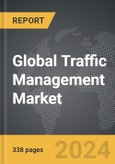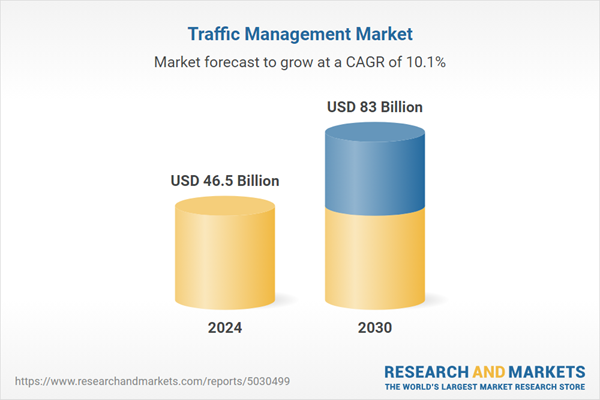The global market for Traffic Management was valued at US$46.5 Billion in 2024 and is projected to reach US$83.0 Billion by 2030, growing at a CAGR of 10.1% from 2024 to 2030. This comprehensive report provides an in-depth analysis of market trends, drivers, and forecasts, helping you make informed business decisions. The report includes the most recent global tariff developments and how they impact the Traffic Management market.
Segments: Component (Solutions, Hardware, Services).
Geographic Regions/Countries: World; United States; Canada; Japan; China; Europe (France; Germany; Italy; United Kingdom; Spain; Russia; and Rest of Europe); Asia-Pacific (Australia; India; South Korea; and Rest of Asia-Pacific); Latin America (Argentina; Brazil; Mexico; and Rest of Latin America); Middle East (Iran; Israel; Saudi Arabia; United Arab Emirates; and Rest of Middle East); and Africa.
The analysts continuously track trade developments worldwide, drawing insights from leading global economists and over 200 industry and policy institutions, including think tanks, trade organizations, and national economic advisory bodies. This intelligence is integrated into forecasting models to provide timely, data-driven analysis of emerging risks and opportunities.
Global Traffic Management Market - Key Trends & Drivers Summarized
What is Traffic Management and Why is it Vital?
Traffic Management encompasses a range of strategies and technologies designed to optimize the flow of vehicles and pedestrians in urban and suburban areas. This includes the use of traffic signals, signage, road markings, and intelligent transportation systems (ITS) to improve road safety, reduce congestion, and enhance the overall efficiency of transportation networks. Effective traffic management is essential for mitigating the adverse effects of traffic congestion, such as increased travel time, air pollution, and fuel consumption. As urban populations grow and vehicle ownership rises, the need for efficient traffic management solutions becomes increasingly critical to ensure smooth and safe mobility.How Does Traffic Management Improve Urban Mobility?
Traffic Management improves urban mobility by employing advanced technologies and data-driven approaches to regulate and streamline traffic flow. Intelligent Traffic Systems (ITS) play a significant role in this, utilizing real-time data from sensors, cameras, and GPS devices to monitor traffic conditions and adjust traffic signals accordingly. Adaptive traffic signal control, dynamic lane management, and real-time traffic information dissemination are some of the key strategies used to alleviate congestion and reduce delays. Additionally, traffic management centers (TMCs) coordinate these efforts, using sophisticated software to analyze traffic patterns and implement timely interventions. These systems not only enhance the efficiency of transportation networks but also improve road safety by minimizing the risk of accidents and ensuring compliance with traffic regulations.Why is Traffic Management Gaining Prominence?
The prominence of Traffic Management is growing due to several factors. Urbanization and population growth are leading to increased vehicle density on roads, necessitating more effective traffic control measures. The rise of smart cities and the integration of IoT (Internet of Things) in urban infrastructure have also propelled the adoption of advanced traffic management solutions. Governments and municipalities are investing in ITS to address traffic-related challenges and improve the quality of life for residents. Environmental concerns, such as reducing carbon emissions and improving air quality, are further driving the need for efficient traffic management. Moreover, the advent of connected and autonomous vehicles requires sophisticated traffic management systems to ensure seamless integration and safe operation within existing transportation networks.What Factors are Driving the Growth of the Traffic Management Market?
The growth in the Traffic Management market is driven by several factors. The rapid urbanization and the consequent increase in vehicle ownership demand more efficient traffic control and management solutions. Technological advancements in ITS, such as AI, machine learning, and IoT, are enhancing the capabilities of traffic management systems, making them more responsive and adaptive to real-time conditions. Government initiatives and substantial investments in smart city projects are also significant drivers, as they aim to develop sustainable and efficient urban transportation infrastructure. Environmental considerations, such as the need to reduce greenhouse gas emissions and improve air quality, further push the adoption of advanced traffic management solutions. Additionally, the increasing complexity of urban transportation networks, coupled with the need for safer and more efficient mobility solutions, is fueling the demand for comprehensive traffic management systems. The rise of autonomous and connected vehicles also necessitates the implementation of sophisticated traffic management systems to ensure their safe and efficient integration into existing traffic systems.Report Scope
The report analyzes the Traffic Management market, presented in terms of units. The analysis covers the key segments and geographic regions outlined below.Segments: Component (Solutions, Hardware, Services).
Geographic Regions/Countries: World; United States; Canada; Japan; China; Europe (France; Germany; Italy; United Kingdom; Spain; Russia; and Rest of Europe); Asia-Pacific (Australia; India; South Korea; and Rest of Asia-Pacific); Latin America (Argentina; Brazil; Mexico; and Rest of Latin America); Middle East (Iran; Israel; Saudi Arabia; United Arab Emirates; and Rest of Middle East); and Africa.
Key Insights:
- Market Growth: Understand the significant growth trajectory of the Solutions segment, which is expected to reach US$41.8 Billion by 2030 with a CAGR of a 10.6%. The Hardware segment is also set to grow at 9.8% CAGR over the analysis period.
- Regional Analysis: Gain insights into the U.S. market, valued at $12.3 Billion in 2024, and China, forecasted to grow at an impressive 13.9% CAGR to reach $18.8 Billion by 2030. Discover growth trends in other key regions, including Japan, Canada, Germany, and the Asia-Pacific.
Why You Should Buy This Report:
- Detailed Market Analysis: Access a thorough analysis of the Global Traffic Management Market, covering all major geographic regions and market segments.
- Competitive Insights: Get an overview of the competitive landscape, including the market presence of major players across different geographies.
- Future Trends and Drivers: Understand the key trends and drivers shaping the future of the Global Traffic Management Market.
- Actionable Insights: Benefit from actionable insights that can help you identify new revenue opportunities and make strategic business decisions.
Key Questions Answered:
- How is the Global Traffic Management Market expected to evolve by 2030?
- What are the main drivers and restraints affecting the market?
- Which market segments will grow the most over the forecast period?
- How will market shares for different regions and segments change by 2030?
- Who are the leading players in the market, and what are their prospects?
Report Features:
- Comprehensive Market Data: Independent analysis of annual sales and market forecasts in US$ Million from 2024 to 2030.
- In-Depth Regional Analysis: Detailed insights into key markets, including the U.S., China, Japan, Canada, Europe, Asia-Pacific, Latin America, Middle East, and Africa.
- Company Profiles: Coverage of players such as Accenture PLC, Cisco Systems, Inc., Cubic Corporation, Indra Sistemas SA, Iteris, Inc. and more.
- Complimentary Updates: Receive free report updates for one year to keep you informed of the latest market developments.
Some of the 171 companies featured in this Traffic Management market report include:
- Accenture PLC
- Cisco Systems, Inc.
- Cubic Corporation
- Indra Sistemas SA
- Iteris, Inc.
- Kapsch TrafficCom AG
- LG CNS Co., Ltd.
- Metro Infrasys Pvt., Ltd.
- Q-Free ASA
- Siemens AG
- SWARCO AG
Tariff Impact Analysis: Key Insights for 2025
Global tariff negotiations across 180+ countries are reshaping supply chains, costs, and competitiveness. This report reflects the latest developments as of April 2025 and incorporates forward-looking insights into the market outlook.The analysts continuously track trade developments worldwide, drawing insights from leading global economists and over 200 industry and policy institutions, including think tanks, trade organizations, and national economic advisory bodies. This intelligence is integrated into forecasting models to provide timely, data-driven analysis of emerging risks and opportunities.
What’s Included in This Edition:
- Tariff-adjusted market forecasts by region and segment
- Analysis of cost and supply chain implications by sourcing and trade exposure
- Strategic insights into geographic shifts
Buyers receive a free July 2025 update with:
- Finalized tariff impacts and new trade agreement effects
- Updated projections reflecting global sourcing and cost shifts
- Expanded country-specific coverage across the industry
Table of Contents
I. METHODOLOGYII. EXECUTIVE SUMMARY2. FOCUS ON SELECT PLAYERSIII. MARKET ANALYSISIV. COMPETITION
1. MARKET OVERVIEW
3. MARKET TRENDS & DRIVERS
4. GLOBAL MARKET PERSPECTIVE
UNITED STATES
CANADA
JAPAN
CHINA
EUROPE
FRANCE
GERMANY
ITALY
UNITED KINGDOM
SPAIN
RUSSIA
REST OF EUROPE
ASIA-PACIFIC
AUSTRALIA
INDIA
SOUTH KOREA
REST OF ASIA-PACIFIC
LATIN AMERICA
ARGENTINA
BRAZIL
MEXICO
REST OF LATIN AMERICA
MIDDLE EAST
IRAN
ISRAEL
SAUDI ARABIA
UNITED ARAB EMIRATES
REST OF MIDDLE EAST
AFRICA
Companies Mentioned (Partial List)
A selection of companies mentioned in this report includes, but is not limited to:
- Accenture PLC
- Cisco Systems, Inc.
- Cubic Corporation
- Indra Sistemas SA
- Iteris, Inc.
- Kapsch TrafficCom AG
- LG CNS Co., Ltd.
- Metro Infrasys Pvt., Ltd.
- Q-Free ASA
- Siemens AG
- SWARCO AG
Table Information
| Report Attribute | Details |
|---|---|
| No. of Pages | 338 |
| Published | April 2025 |
| Forecast Period | 2024 - 2030 |
| Estimated Market Value ( USD | $ 46.5 Billion |
| Forecasted Market Value ( USD | $ 83 Billion |
| Compound Annual Growth Rate | 10.1% |
| Regions Covered | Global |









